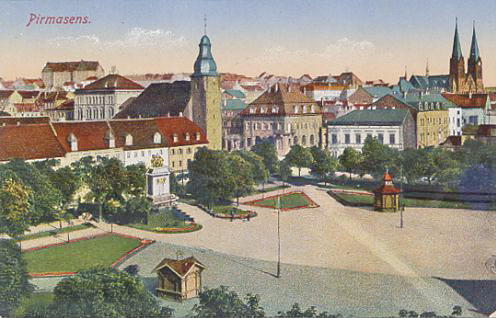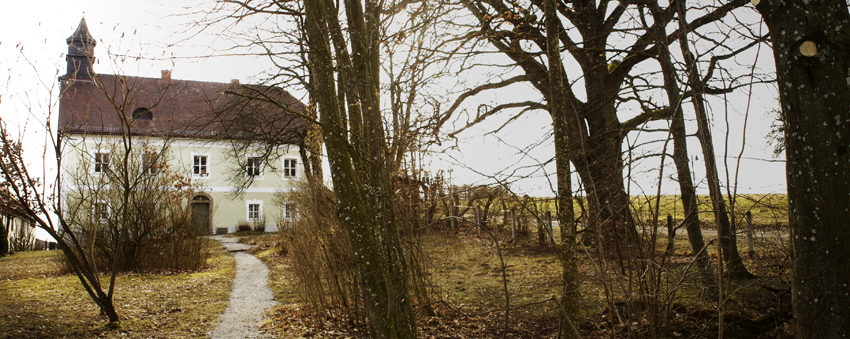|
Hanns Diehl
Hanns Diehl (13 March 1877 – 22 December 1946) was a German-Austrian artist influential as the founder of Vienna's Künstlerbund Segantini (1921–1938). Early life Hanns Diehl was born Hans Rudolf Diehl in Pirmasens, Rhineland-Palatinate, Germany, as the second son of August Diehl and Julia (née Herb), a mechanical engineer and factory owner. He spent his earliest childhood years in Pirmasens until his father’s business sent the family to Moscow. Here Hanns studied Russian and attended his first four years of school at the Petri-Pauli Realgymnasium; he wrote later that his happiest memories as a boy were connected with his Russian life, where he often wandered through the magnificent forests surrounding the city and drew nature studies under the guidance of his mother. He described his mother as "...a not untalented dilettante who possessed a sharp eye and a striking judgment about graphic form". Education The family moved back to Germany in the 1890s, to Weimar, where Die ... [...More Info...] [...Related Items...] OR: [Wikipedia] [Google] [Baidu] |
Pirmasens
Pirmasens (; pfl, Bärmesens (also ''Bermesens'' or ''Bärmasens'')) is an independent town in Rhineland-Palatinate, Germany, near the border with France. It was famous for the manufacture of shoes. The surrounding rural district was called ''Landkreis Pirmasens'' from 1818 until 1997, when it was renamed to ''Südwestpfalz''. Pirmasens can be easily mistaken with ''Primasens'', of which means a first sense in Latin-derived languages (the first sense in Latin would be "primus sensus"). History Early years The first mention of "Pirminiseusna", a colony of Hornbach Abbey, dates from 860. The name derives from St. Pirminius, the founder of the monastery. During the period it was under rule of the Bishopric of Metz. It was passed to Diocese of Speyer in last the quarter of the 11th century, then was captured by County of Saarbrücken in 1100. In 1182, the County of Saarbrücken was divided by Simon II and Henry I, who were sons of Simon I. Pirmasens was given to the latter and He ... [...More Info...] [...Related Items...] OR: [Wikipedia] [Google] [Baidu] |
Giovanni Segantini
Giovanni Segantini (15 January 1858 – 28 September 1899) was an Italian painter known for his large pastoral landscapes of the Alps. He was one of the most famous artists in Europe in the late 19th century, and his paintings were collected by major museums. In later life, he combined a Divisionist painting style with Symbolist images of nature. He was active in Switzerland during the last period of his life. Biography Giovanni Battista Emanuele Maria Segatini 'sic''was born at Arco in Trentino, which was then part of the County of Tyrol in the Austro-Hungarian Empire. He later changed his family name by adding an "n" after the "a". He was the second child of Agostino Segatini (1802–1866) and Margarita De Girardi (1828–1865). His older brother, Lodovico, died in a fire the year Giovanni was born. During the first seven years of his life, his father, who was a tradesman, traveled extensively while looking for work. Except for a six-month period in 1864 when Agostino re ... [...More Info...] [...Related Items...] OR: [Wikipedia] [Google] [Baidu] |
1877 Births
Events January–March * January 1 – Queen Victoria is proclaimed ''Empress of India'' by the ''Royal Titles Act 1876'', introduced by Benjamin Disraeli, the Prime Minister of the United Kingdom . * January 8 – Great Sioux War of 1876 – Battle of Wolf Mountain: Crazy Horse and his warriors fight their last battle with the United States Cavalry in Montana. * January 20 – The Conference of Constantinople ends, with Ottoman Turkey rejecting proposals of internal reform and Balkan provisions. * January 29 – The Satsuma Rebellion, a revolt of disaffected samurai in Japan, breaks out against the new imperial government; it lasts until September, when it is crushed by a professionally led army of draftees. * February 17 – Major General Charles George Gordon of the British Army is appointed Governor-General of the Sudan. * March – ''The Nineteenth Century (periodical), The Nineteenth Century'' magazine is founded in London. * Marc ... [...More Info...] [...Related Items...] OR: [Wikipedia] [Google] [Baidu] |
1946 Deaths
Events January * January 6 - The first general election ever in Vietnam is held. * January 7 – The Allies recognize the Austrian republic with its 1937 borders, and divide the country into four occupation zones. * January 10 ** The first meeting of the United Nations is held, at Methodist Central Hall Westminster in London. ** ''Project Diana'' bounces radar waves off the Moon, measuring the exact distance between the Earth and the Moon, and proves that communication is possible between Earth and outer space, effectively opening the Space Age. * January 11 - Enver Hoxha declares the People's Republic of Albania, with himself as prime minister. * January 16 – Charles de Gaulle resigns as head of the French provisional government. * January 17 - The United Nations Security Council holds its first session, at Church House, Westminster in London. * January 19 ** The Bell XS-1 is test flown for the first time (unpowered), with Bell's chief test pilot Jack Woolams at t ... [...More Info...] [...Related Items...] OR: [Wikipedia] [Google] [Baidu] |
Das Interessante Blatt
''Das Interessante Blatt'' was an Austrian magazine which appeared weekly from 1882 to 1939. A supplement of the newspaper appeared under the title Wiener Bilder Wiener Bilder; () was the illustrated supplement of the Austrian conservative weekly newspaper Das interessante Blatt which appeared weekly from 1882 to 1939. History From 26 June 1898 to 9 July 1898, a special edition was published under the ..., their successor newspaper was the ''Wiener Illustrierte''. Bibliography * Helmut W. Lang (editor): ''Österreichische Retrospektive Bibliographie'' on Amazon (ORBI). Reihe 2: ''Österreichische Zeitungen 1492–1945.'' Volume 2: Helmut W. Lang, Ladislaus Lang, Wilma Buchinger: ''Bib ... [...More Info...] [...Related Items...] OR: [Wikipedia] [Google] [Baidu] |
Anschluss
The (, or , ), also known as the (, en, Annexation of Austria), was the annexation of the Federal State of Austria into the German Reich on 13 March 1938. The idea of an (a united Austria and Germany that would form a " Greater Germany") began after the unification of Germany excluded Austria and the German Austrians from the Prussian-dominated German Empire in 1871. Following the end of World War I with the fall of the Austro-Hungarian Empire, in 1918, the newly formed Republic of German-Austria attempted to form a union with Germany, but the Treaty of Saint Germain (10 September 1919) and the Treaty of Versailles (28 June 1919) forbade both the union and the continued use of the name "German-Austria" (); and stripped Austria of some of its territories, such as the Sudetenland. Prior to the , there had been strong support in both Austria and Germany for unification of the two countries. In the immediate aftermath of the dissolution of the Habsburg monarchy—with ... [...More Info...] [...Related Items...] OR: [Wikipedia] [Google] [Baidu] |
Nazi Party
The Nazi Party, officially the National Socialist German Workers' Party (german: Nationalsozialistische Deutsche Arbeiterpartei or NSDAP), was a far-right politics, far-right political party in Germany active between 1920 and 1945 that created and supported the ideology of Nazism. Its precursor, the German Workers' Party (; DAP), existed from 1919 to 1920. The Nazi Party emerged from the Extremism, extremist German nationalism, German nationalist, racism, racist and populism, populist paramilitary culture, which fought against the communism, communist uprisings in post–World War I Germany. The party was created to draw workers away from communism and into nationalism. Initially, Nazi political strategy focused on anti–big business, anti-bourgeoisie, bourgeois, and anti-capitalism, anti-capitalist rhetoric. This was later downplayed to gain the support of business leaders, and in the 1930s, the party's main focus shifted to Antisemitism, antisemitic and Criticism of ... [...More Info...] [...Related Items...] OR: [Wikipedia] [Google] [Baidu] |
Lyonel Feininger
Lyonel Charles Feininger (July 17, 1871January 13, 1956) was a German-American painter, and a leading exponent of Expressionism. He also worked as a caricaturist and comic strip artist. He was born and grew up in New York City, traveling to Germany at 16 to study and perfect his art. He started his career as a cartoonist in 1894 and met with much success in this area. He was also a commercial caricaturist for 20 years for magazines and newspapers in the USA and Germany. At the age of 36, he started to work as a fine artist. He also produced a large body of photographic works between 1928 and the mid 1950s, but he kept these primarily within his circle of friends. He was also a pianist and composer, with several piano compositions and fugues for organ extant. Life and work Lyonel Feininger was born to German-American violinist and composer Karl Feininger and American singer Elizabeth Feininger. He was born and grew up in New York City, but traveled to Germany at the age of 16 in ... [...More Info...] [...Related Items...] OR: [Wikipedia] [Google] [Baidu] |
Alfred Kubin
Alfred Leopold Isidor Kubin (10 April 1877 – 20 August 1959) was an Austrian printmaker, illustrator, and occasional writer. Kubin is considered an important representative of Symbolism (arts), Symbolism and Expressionism. Biography Kubin was born in Kingdom of Bohemia, Bohemia in the town of Leitmeritz, Austro-Hungarian Empire (now Litoměřice). From 1892 to 1896, he was apprenticed to the Landscape photography, landscape photographer Alois Beer, although he learned little. In 1896, he attempted suicide on his mother's grave, and his short stint in the Austrian army the following year ended with a nervous breakdown. In 1898, Kubin began a period of artistic study at a private academy run by the painter Ludwig Schmitt-Reutte, before enrolling at the Academy of Fine Arts Munich, Munich Academy in 1899, without finishing his studies there. In Munich, Kubin discovered the works of Odilon Redon, Edvard Munch, James Ensor, Henry de Groux, and Félicien Rops. He was profoundly affe ... [...More Info...] [...Related Items...] OR: [Wikipedia] [Google] [Baidu] |
Emil Nolde
Emil Nolde (born Hans Emil Hansen; 7 August 1867 – 13 April 1956) was a German-Danish painter and printmaker. He was one of the first Expressionists, a member of Die Brücke, and was one of the first oil painting and watercolor painters of the early 20th century to explore color. He is known for his brushwork and expressive choice of colors. Golden yellows and deep reds appear frequently in his work, giving a luminous quality to otherwise somber tones. His watercolors include vivid, brooding storm-scapes and brilliant florals. Nolde's intense preoccupation with the subject of flowers reflected his interest in the art of Vincent van Gogh. Even though his art was included in the ''Entartete Kunst'' exhibition of 1937, Nolde was a racist, anti-semite and a staunch supporter of Nazi Germany. Biography Emil Nolde was born as Hans Emil Hansen, near the village of Nolde (since 1920 part of the municipality of Burkal in Southern Jutland, Denmark), in the Prussian Duchy of Schleswig ... [...More Info...] [...Related Items...] OR: [Wikipedia] [Google] [Baidu] |
Diehl Affenballade
Diehl may refer to: People Surname Arts * Arthur Diehl (1870–1929), English impressionist landscape artist *Carol Diehl, American artist, art critic and poet *Guy Diehl (born 1949), American painter *Gaston Diehl (1912–1999), French professor of art history and art critic *Hanns Diehl (1877–1946), German-Austrian painter *Volker Diehl (born 1957), German art gallery owner Acting *August Diehl (born 1976), German actor * John Diehl (actor) (born 1950), American character actor * Karl Ludwig Diehl (1896–1958), German film actor Entertainment *Aaron Diehl (born 1985), American jazz pianist *Alden Diehl (1931–2000), Canadian radio executive and comedian * Alex Diehl (born 1987), German singer and songwriter *Alice M. Diehl (1844-1912), English musician and writer *Caroline Diehl, British media executive Politics * Conrad Diehl (1843–1918), American politician, mayor of Buffalo * Geoff Diehl (born 1969), American politician in Massachusetts * Guida Diehl (1868–1961), Ge ... [...More Info...] [...Related Items...] OR: [Wikipedia] [Google] [Baidu] |





